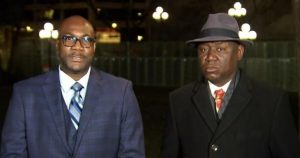
On May 25, Minneapolis police officers arrested George Floyd, a 46-year-old Black man, after a convenience store employee called 911 to report that Mr. Floyd had bought cigarettes with a counterfeit $20 bill. Seventeen minutes after the first squad car arrived at the scene, Mr. Floyd was unconscious and pinned beneath three police officers, showing no signs of life.
By combining videos from bystanders and security cameras, reviewing official documents and consulting experts, The New York Times reconstructed in detail the minutes leading to Mr. Floyd’s death. Our video shows officers taking a series of actions that violated the policies of the Minneapolis Police Department and turned fatal, leaving Mr. Floyd unable to breathe, even as he and onlookers called out for help.

The trial of Derek Chauvin in the death of George Floyd will be unusual for many reasons: It will be livestreamed from Minneapolis, attendance will be severely limited because of the coronavirus, and the public’s interest in the case may make this one of the highest-profile trials in recent memory.
The trial can be watched on nytimes.com, via a livestream provided by Court TV. Opening statements are expected to begin around 10:30 a.m. Eastern on Monday. Witness testimony and lawyers’ presentation of evidence should last several weeks before the jury begins to deliberate over the verdict.
Among the people allowed in the courtroom, on the 18th floor of the Hennepin County Government Center, are the judge, jurors, witnesses, court staff, lawyers, Mr. Chauvin, and only a handful of spectators. The judge, Peter A. Cahill, wrote in an order on March 1 that only one member of Mr. Floyd’s family and one member of Mr. Chauvin’s family would be allowed in the room at any time. Two seats will be reserved for reporters, and various journalists, including from The New York Times, will rotate throughout the trial.
The lawyers, spectators, jurors and witnesses will be required to wear masks when they are not speaking. Spectators are prohibited from having any visible images, logos, letters or numbers on their masks or clothing, according to Judge Cahill’s order.

MINNEAPOLIS — Opening statements in the murder trial of Derek Chauvin, the former police officer charged in the death of George Floyd, begin Monday morning in a heavily fortified courthouse in downtown Minneapolis.
The trial begins 10 months after Mr. Floyd, a Black man, died last May after being held down by police officers on a South Minneapolis street corner in an episode that was captured on a cellphone video and set off protests for racial justice around the nation. Mr. Chauvin, who is white, pressed his knee on Mr. Floyd’s neck for more than nine minutes, ignoring Mr. Floyd’s repeated pleas that he could not breathe and his cries for his mother.
For a country that rarely holds police officers accountable for killing people on the job, especially Black people, the trial is a test of whether the criminal justice system has changed after Mr. Floyd’s death. The case is the most pivotal police brutality trial since the beating of Rodney King in Los Angeles in the early 1990s.
Against the backdrop of the ongoing struggle to reform policing and push the nation forward on matters of racial justice, the trial will be fought on the narrower grounds of toxicology reports, medical records and police training manuals. Mr. Chauvin is charged with second-degree murder, third-degree murder and manslaughter.
Above all, the case is likely to turn on one central question: What caused Mr. Floyd’s death?
The centerpiece of Mr. Chauvin’s defense strategy, as laid out in motions and pretrial arguments, is making the case that Mr. Floyd died of a drug overdose — a toxicology report showed fentanyl and methamphetamine in his system — complicated by underlying health conditions.
The prosecution will try to convince the jury that Mr. Chauvin’s knee on Mr. Floyd’s neck for so long was a substantial factor in his death, regardless of the amount of drugs in his system, and his health problems.






